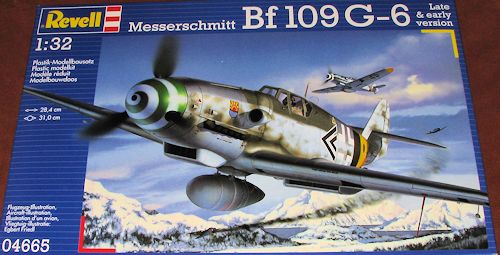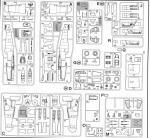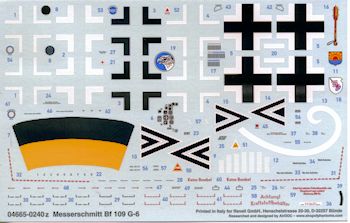
Revell 1/32 Bf-109G-6
| KIT #: | 04665 |
| PRICE: | $29.99 SRP |
| DECALS: | Two options |
| REVIEWER: | Scott Van Aken |
| NOTES: | New tool kit |

| HISTORY |
In February 1943, the G-6 was introduced on the production line with the 13 mm (.51 in) MG 131s, replacing the smaller 7.92 mm (.312 in) MG 17 – externally this resulted in two sizeable Beule blisters over the gun breeches, reducing speed by 9 km/h (6 mph). Over 12,000 examples were built well into 1944 although contradictory factory and RLM records do not allow an exact tally. The G-5 with a pressurized cockpit was identical to the G-6. A total of 475 examples were built between May 1943 and August 1944. The G-5/AS was equipped with a DB 605AS engine for high-altitude missions. GM-1-boosted G-5 and G-6 variants received the additional designation of "/U2". and were clearly identifyable as they use a modified, aerodynamically cleaner, engine cowl without the usual blisters.
The G-6/U4 variant was armed with a 30 mm (1.18 in) MK 108 cannon mounted as a Motorkanone firing through the propeller hub instead of the 20 mm MG 151/20. The G-6 was very often seen during 1943 fitted with assembly sets, used to carry bombs or a drop tank, for use as a night fighter, or to increase firepower by adding rockets or extra gondola guns.
The following variants of the G-5 and G-6 were produced:
One offensive weapons upgrade in 1943 for the Bf 109G was one that mounted the Army`s Werfer-Granate 21 rocket weapon system with one launching tube under each wing panel. The rockets, fitted with a massive 40,8 kg (90 lbs) warhead, were aimed via the standard Revi reflector sights, and were spin-stabilized in flight. In emergency, the tubes could be jettisoned via a small explosive charge. Intended as a "stand-off" weapon, fired from a distance of 1,200 meters and outside the effective range of the formations defensive guns, it was employed against Allied bomber formations, the Wfr. Gr. 21 rocket was unofficially known as the BR 21 (Bordrakete 21 cm) for the Bf 109G-5, G-6 and G-14. The weapons system received the designation of Rüstsatz VII on the G-10.
During the course of 1943, a number of improvements were gradually introduced. In an attempt to increase the pilot's field of view an armoured glass head-rest, the so-called Galland Panzer was developed, and subsequently began replacing the bulky armour plate in the spring of 1943. Towards the end of the year the clear-view Erla Haube canopy appeared, named after the Erla Maschinenwerk sub-contractor involved in building new examples, and upgrading older examples of the Bf 109. Often misnamed the "Galland Hood" in postwar Western aviation books and periodicals, it eventually replaced the older heavily framed two-piece canopy on the Bf 109G. The canopy structure was completely redesigned to incorporate a greater area of clear perspex; the welded framing was reduced to a minimum and there was no longer a fixed rear portion, with the entire structure aft of the windscreen being hinged to swing to starboard when opened.
The Bf 109 G-10, AS-engined G-5s, G-6s and G-14s as well as the K-4 saw a refinement of the engine cowlings. The Beule blisters which had formerly covered the spent shell-casing chutes of the synchronized fuselage-mount MG 131s became more streamlined and were lengthened and enlarged to cover both the weapons and the engine bearers. Initial prototype versions were symmetrical, but as larger superchargers were fitted, the engines required modified upper engine bearers to clear the supercharger housing, and as a result the final shape of the new cowling was asymmetrical, being enlarged on the port side where the supercharger was mounted on the DB engine. There were also special streamlined panels fitted to the forward fuselage. These so-called agglomerations could be seen in several different patterns. Because of their aerodynamically more efficient form in a side-view of DB 605AS and D -powered Bf 109 Gs and Ks, the agglomerations were barely discernible compared with the conspicuous fairings they replaced.
Some versions of the G-6 and later Gs had a taller, wood-structure tail unit and redesigned rudder which improved stability at high speeds. The introduction of the WGr. 21 cm (8 in) under-wing mortar/rockets and the 30 mm (1.18 in) MK 108 cannon increased firepower. Certain production batches of the Bf 109G were fitted with aileron Flettner tabs to decrease stick forces at high speeds. A radio-navigational method, the Y-Verführung (Y-Guidance) was introduced with the FuG 16ZY.
Subsequent Bf 109G versions were essentially modified versions of the basic G-6 airframe. Early in 1944, new engines with larger superchargers for improved high-altitude performance (DB 605AS), or with MW-50 water injection for improved low/medium-altitude performance (DB 605AM), or these two features combined (DB 605ASM) were introduced into the Bf 109 G-6. Maximum speed of the G-5/G-6 was 530 km/h (320 mph) at sea level, 640 km/h (391 mph) at 6,600 m (21,650 ft)-rated altitude at 1.42 atm boost.
| THE KIT |
 I
am sure that by now, many of you are aware of Revell AG's new 1/32 Bf-109G. I am
a fan of the type and despite having several Hasegawa kits in my stash, I picked
this one up to see what it was like. Now I'm not a hard core 109 fan-boy, but I
do like the type, so I've probably missed all the 'horrible inaccuracies' that
would make the kit 'unbuildable'. At least that is what one often hears from
'those who know' about pretty much everything new that gets released.
I
am sure that by now, many of you are aware of Revell AG's new 1/32 Bf-109G. I am
a fan of the type and despite having several Hasegawa kits in my stash, I picked
this one up to see what it was like. Now I'm not a hard core 109 fan-boy, but I
do like the type, so I've probably missed all the 'horrible inaccuracies' that
would make the kit 'unbuildable'. At least that is what one often hears from
'those who know' about pretty much everything new that gets released.
First thing that struck me is that you get a lot of nicely molded plastic for your money. The end opening box is crammed full of sprues. The next impression was that there are a lot of inserts. Don't like inserts, well, you will not be building this kit as it is pretty obvious from looking at the way the kit is designed that Revell AG will be doing other variants.
Looking over the instructions I noticed that the part numbers are listed, but not the sprue on which they are attached. This will mean some hunting around for parts during construction. I then noticed errors in the first two of the 81 construction steps. Step one shows a foot plate of either part #7 or #8. Couldn't find a #7 no matter how much I looked at the sprues. Second step shows the MK.108 cannon as going on the early 109 and the 151/20 going on the late. Fortunately, though the labeling is backwards, it appears that the actual parts are correct.
As you'd expect, there is a lot of detail in the cockpit. The rear bulkhead and seat pan have belts molded in place. There are separate fuel lines and oxygen lines for the right side of the cockpit with the trim cables being separate on the left. Two different gun sights are provided depending on the variant. For the upper aft bulkhead, you get a choice of one with the bulge on it for what I think is the MW-50 system and a standard version. A wing spar attaches to the bottom of the completed cockpit assembly. Exhaust are designed to be installed from the inside, which will make painting a bit of an issue unless you want to wait until near the end to install the cowling sides.
Two different upper cowlings are provided with no indication of which is to be used on which markings option. There are also two different right cowling side panels depending on whether you use the MW-50 system. There are also early/late right side gun bulges. Wheel wells are made up of separate small straight sections to box in the well. If doing a late plane, there is a lower wing insert for the morane antenna. Revell decided to incorporate the wheel bulge into the upper wing section, but in this case it means that though there is a single lower wing, there are two upper wing bits on each side.
The kit comes with two sets of elevators and tail planes but that is due to their being two of the same sprues on which one has a myriad of other bits. Now, one can do either an early rudder with the notch or the later version with the tall wooden fin. The upper portion of the fin is separate to incorporate this change. Though not shown in the instructions, there are two types of tall rudder provided and you are directed to remove the trim tabs from the one shown in the instructions. I am sure these additional rudders are for a G-10 or K. One can model the slats, flaps and radiator exhaust openings in a variety of positions. The separate elevators and ailerons also provide an ability to pose those in something other than the neutral position.
I should mention that both the main gear lets and upper tail gear are molded in left and right halves. I am sure that when Scale Aircraft Conversions offers metal gear for this kit that these items will be a single construct. These can also be put in the closed position if one wants an in flight model. There are a variety of resin pilots on the market that should fill the bill for this kit if that is your choice.
The only thing for under the fuselage is a drop tank and its rack. There are two different canopies provided; one being standard and the other the Erla Haube version. Each has its own specific head armor. Two different windscreens are provided, but no indication as to which option uses which. The difference is in the right forward side. One has a scoop and the other has a Very pistol port. The canopy sections can be posed open or closed and if closed, small tabs will need to be cut from the airframe. The prop consists of separate blades which are keyed so no worries on angle issues.
 Instructions
are typical Revell AG with only Revell paint information during the build
itself. RLM numbers are provided for the overall camouflage. Two markings
options are provided on the large swastika-free decal sheet. One is the box art
plane from Stab III./JG 5 based in Norway at the end of the war. The
instructions state a late war color scheme but only offer the usual RLM 74/75/76
scheme. This aircraft has yellow lower wing tips. The other is from April 1944
in Rumania and is an aircraft of Stab II./JG 51. It is also in RLM 74/75/76 with
yellow under the cowling, wing tips and on the fuselage band. The rudder on this
one is white. Decals look to be very well done and for those wanting something
else, there are a lot of aftermarket sheets for the big 109G and I'm sure more
are on the way.
Instructions
are typical Revell AG with only Revell paint information during the build
itself. RLM numbers are provided for the overall camouflage. Two markings
options are provided on the large swastika-free decal sheet. One is the box art
plane from Stab III./JG 5 based in Norway at the end of the war. The
instructions state a late war color scheme but only offer the usual RLM 74/75/76
scheme. This aircraft has yellow lower wing tips. The other is from April 1944
in Rumania and is an aircraft of Stab II./JG 51. It is also in RLM 74/75/76 with
yellow under the cowling, wing tips and on the fuselage band. The rudder on this
one is white. Decals look to be very well done and for those wanting something
else, there are a lot of aftermarket sheets for the big 109G and I'm sure more
are on the way.
| CONCLUSIONS |
So what is my take on this one? I like it. All the inserts are not exactly what I like to deal with, but it is so typical of kits nowadays that one just has to live with it. There are also so many nice optional bits that one with a bit of reference will be able to do just about any G-6 variant save those with the later, smoother cowling. Any hopes of doing an earlier G model will be dashed by the lack of early wheels, the need to do some major surgery on the inner upper wing section, and lack of the thinner prop at the very least. However, I am sure the aftermarket folks will accommodate those wanting to backdate this kit, assuming that RoG doesn't rather quickly release other versions. With the Hasegawa kit reaching double the retail price of this one, it is very much a viable alternative and a very nice addition to RoG's growling catalogue of big scale kits.
| REFERENCES |
http://en.wikipedia.org/wiki/Messerschmitt_Bf_109_variants#G-5.2C_G-6
September 2013
Thanks to me for picking up the preview kit.
If you would like your product reviewed fairly and fairly quickly, please contact the editor or see other details in the Note to Contributors.